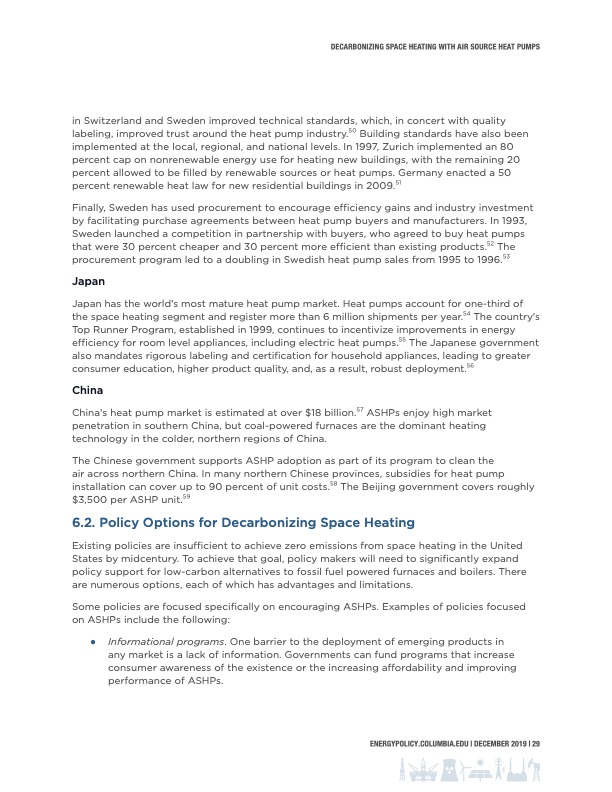
PDF Publication Title:
Text from PDF Page: 030
in Switzerland and Sweden improved technical standards, which, in concert with quality labeling, improved trust around the heat pump industry.50 Building standards have also been implemented at the local, regional, and national levels. In 1997, Zurich implemented an 80 percent cap on nonrenewable energy use for heating new buildings, with the remaining 20 percent allowed to be filled by renewable sources or heat pumps. Germany enacted a 50 percent renewable heat law for new residential buildings in 2009.51 Finally, Sweden has used procurement to encourage efficiency gains and industry investment by facilitating purchase agreements between heat pump buyers and manufacturers. In 1993, Sweden launched a competition in partnership with buyers, who agreed to buy heat pumps that were 30 percent cheaper and 30 percent more efficient than existing products.52 The procurement program led to a doubling in Swedish heat pump sales from 1995 to 1996.53 Japan Japan has the world’s most mature heat pump market. Heat pumps account for one-third of the space heating segment and register more than 6 million shipments per year.54 The country’s Top Runner Program, established in 1999, continues to incentivize improvements in energy efficiency for room level appliances, including electric heat pumps.55 The Japanese government also mandates rigorous labeling and certification for household appliances, leading to greater consumer education, higher product quality, and, as a result, robust deployment.56 China China’s heat pump market is estimated at over $18 billion.57 ASHPs enjoy high market penetration in southern China, but coal-powered furnaces are the dominant heating technology in the colder, northern regions of China. The Chinese government supports ASHP adoption as part of its program to clean the air across northern China. In many northern Chinese provinces, subsidies for heat pump installation can cover up to 90 percent of unit costs.58 The Beijing government covers roughly $3,500 per ASHP unit.59 6.2. Policy Options for Decarbonizing Space Heating Existing policies are insufficient to achieve zero emissions from space heating in the United States by midcentury. To achieve that goal, policy makers will need to significantly expand policy support for low-carbon alternatives to fossil fuel powered furnaces and boilers. There are numerous options, each of which has advantages and limitations. Some policies are focused specifically on encouraging ASHPs. Examples of policies focused on ASHPs include the following: ● Informational programs. One barrier to the deployment of emerging products in any market is a lack of information. Governments can fund programs that increase consumer awareness of the existence or the increasing affordability and improving performance of ASHPs. DECARBONIZING SPACE HEATING WITH AIR SOURCE HEAT PUMPS ENERGYPOLICY.COLUMBIA.EDU | DECEMBER 2019 | 29PDF Image | DECARBONIZING SPACE HEATING WITH HEAT PUMPS

PDF Search Title:
DECARBONIZING SPACE HEATING WITH HEAT PUMPSOriginal File Name Searched:
HeatPump-CGEP_Report_010220.pdfDIY PDF Search: Google It | Yahoo | Bing
CO2 Organic Rankine Cycle Experimenter Platform The supercritical CO2 phase change system is both a heat pump and organic rankine cycle which can be used for those purposes and as a supercritical extractor for advanced subcritical and supercritical extraction technology. Uses include producing nanoparticles, precious metal CO2 extraction, lithium battery recycling, and other applications... More Info
Heat Pumps CO2 ORC Heat Pump System Platform More Info
| CONTACT TEL: 608-238-6001 Email: greg@infinityturbine.com | RSS | AMP |